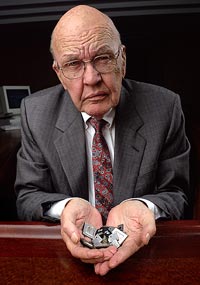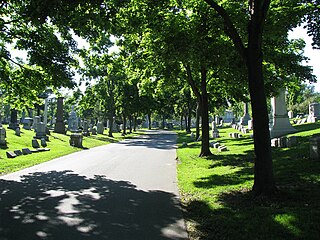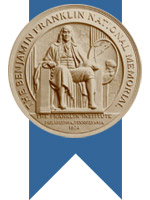Related Research Articles

Jack St. Clair Kilby was an American electrical engineer who took part in the realization of the first integrated circuit while working at Texas Instruments (TI) in 1958. He was awarded the Nobel Prize in Physics on December 10, 2000. Kilby was also the co-inventor of the handheld calculator and the thermal printer, for which he had the patents. He also had patents for seven other inventions.

Robert Heath Dennard is an American electrical engineer and inventor.

Willis Haviland Carrier was an American engineer, best known for inventing modern air conditioning. Carrier invented the first electrical air conditioning unit in 1902. In 1915, he founded Carrier Corporation, a company specializing in the manufacture and distribution of heating, ventilation, and air conditioning (HVAC) systems.

Edmund Germer was a German inventor, recognized as the father of the fluorescent lamp. His father was an accountant. He obtained a doctorate from the University of Berlin in lighting technology.
Charles Paulson Ginsburg was an American engineer and the leader of a research team at Ampex which developed one of the first practical videotape recorders.

Forest Lawn Cemetery is a historic rural cemetery in Buffalo, New York, founded in 1849 by Charles E. Clarke. It covers over 269 acres (1.1 km2) and over 152,000 are buried there, including U.S. President Millard Fillmore, First Lady Abigail Fillmore, singer Rick James, Congresswoman Shirley Chisholm, and inventor Lawrence Dale Bell. Forest Lawn is on the National Register of Historic Places.

George Washington Pierce was an American physicist. He was a professor of physics at Harvard University and inventor in the development of electronic telecommunications.
The IEEE Edison Medal is presented by the Institute of Electrical and Electronics Engineers (IEEE) "for a career of meritorious achievement in electrical science, electrical engineering, or the electrical arts." It is the oldest medal in this field of engineering. The award consists of a gold medal, bronze replica, small gold replica, certificate, and honorarium. The medal may only be awarded to a new leap/breakthrough in the technological area of science.

The Faraday Medal is a top international medal awarded by the UK Institution of Engineering and Technology (IET). It is part of the IET Achievement Medals collection of awards. The medal is named after the famous Michael Faraday FRS, the father of electromagnetism. Faraday is widely recognized as a top scientist, engineer, chemist, and inventor. His electromagnetic induction principles have been widely used in electric motors and generators today.
Reinhold Rudenberg was a German-American electrical engineer and inventor, credited with many innovations in the electric power and related fields. Aside from improvements in electric power equipment, especially large alternating current generators, among others were the electrostatic-lens electron microscope, carrier-current communications on power lines, a form of phased array radar, an explanation of power blackouts, preferred number series, and the number prefix "Giga-".

The Franklin Institute Awards is an American science and engineering award presented by the Franklin Institute, a science museum in Philadelphia. The Franklin Institute awards comprises the Benjamin Franklin Medals in seven areas of science and engineering, the Bower Awards and Prize for Achievement in Science, and the Bower Award for Business Leadership. Since 1824, the institute has recognized "world-changing scientists, engineers, inventors, and industrialists—all of whom reflect Benjamin Franklin’s spirit of curiosity, ingenuity, and innovation". Some of the noted past laureates include Nikola Tesla, Thomas Edison, Marie Curie, Max Planck, Albert Einstein, Stephen Hawking. Some of the 21st century laureates of the institute awards are Bill Gates, James P. Allison, Indra Nooyi, Jane Goodall, Elizabeth Blackburn, George Church, Robert S. Langer, and Alex Gorsky.

Lift slab construction is a method of constructing concrete buildings by casting the floor or roof slab on top of the previous slab and then raising (jacking) the slab up with hydraulic jacks. This method of construction allows for a large portion of the work to be completed at ground level, negating the need to form floor work in place. The ability to create monolithic concrete slabs makes the lift slab construction technique useful in quickly creating structures with repetitive form work, like parking ramps.
The John Fritz Medal has been awarded annually since 1902 by the American Association of Engineering Societies (AAES) for "outstanding scientific or industrial achievements". The medal was created for the 80th birthday of John Fritz, who lived between 1822 and 1913. When AAES was dissolved in 2020, the administration of the Fritz medal was transferred to the American Institute of Mining, Metallurgical, and Petroleum Engineers (AIME), and is currently coordinated by AIME member society, the Society of Mining, Metallurgy, & Exploration (SME).
The Stuart Ballantine Medal was a science and engineering award presented by the Franklin Institute, of Philadelphia, Pennsylvania, USA. It was named after the US inventor Stuart Ballantine.

Julius Kahn was an American engineer, industrialist, and manufacturer. He was the inventor of the Kahn system, a reinforced concrete engineering technique for building construction. The Kahn system, which he patented in 1903, was used worldwide for housing, factories, offices and industrial buildings. He formed his own company, Trussed Concrete Steel Company, as a manufacturing source for his inventions. He also founded United Steel Company and was chairman of Truscon Laboratories.
Samuel Arnold Greeley was an American civil engineer. He was largely responsible for the North Shore Sanitary District works from 1913 until 1963, and founded the engineering firm of Greeley & Hansen Consulting Engineers in 1914.
Ervin George Bailey was an American mechanical engineer, founding president of Bailey Meter Company, manufacturer of industrial meters and controls, and inventor. He was recipient of the 1942 ASME Medal, and served as 67th president of the American Society of Mechanical Engineers.
Barbara Haviland Minor is an American chemical engineer who has worked at DuPont and Chemours. She develops new refrigerants to be used in air conditioning and refrigeration systems, in Europe, North America, Australia and other countries. As of 2018, 50% of all new vehicles produced by original equipment manufacturers (OEMs) are believed to use her refrigerant, HFO-1234yf, an important contribution to countering global warming.
Frank William Peek Jr. was an American electrical engineer and inventor, known as a pioneer in engineering research on the creation of extremely high voltage electricity. He is often given the sobriquet "inventor of man-made lightning". He is known for Peek's law.
References
- ↑ Willis Haviland Carrier 1941 Engineering Brown
- ↑ Journal of the Boston Society of Civil Engineers, Volumes 45-47 Boston Society of Civil Engineers
- ↑ MedalArtists.com
- ↑ Oral-History:Humboldt W. Leverenz "He received the Franklin Institute Brown Medal in 1954 for his contributions to the development of the fluorescent lamp. Head of RCA Laboratories, developed a Periodic Chart of the Elements
- ↑ Air-conditioning America: Engineers and the Controlled Environment, 1900-1960 Gail Cooper; JHU Press, 2002 ;227 pages; page 171 and notes,
- ↑ Youtz, Philip Newell, 1895-1972 Architect, curator, inventor and educator
- ↑ Development of heat pipes for foundations in Arctic regions
- ↑ "US Patent. Permafrost structural support with heat pipe stabilization, Inventor. E. Waters". patents.google.com.
- ↑ "Elmer Dale Waters". Sunset Gardens Obituaries.
- ↑ Introduction of Ben C. Gerwick Jr., Recipient of the 2001 Ralph B. Peck Award American Society of Civil Engineers
- ↑ Eye on People Jewish Post, "He received the prestigious Franklin Pierce Brown Medal for scientific achievement in 1989"
- ↑ "Search Laureates". The Franklin Institute Awards.